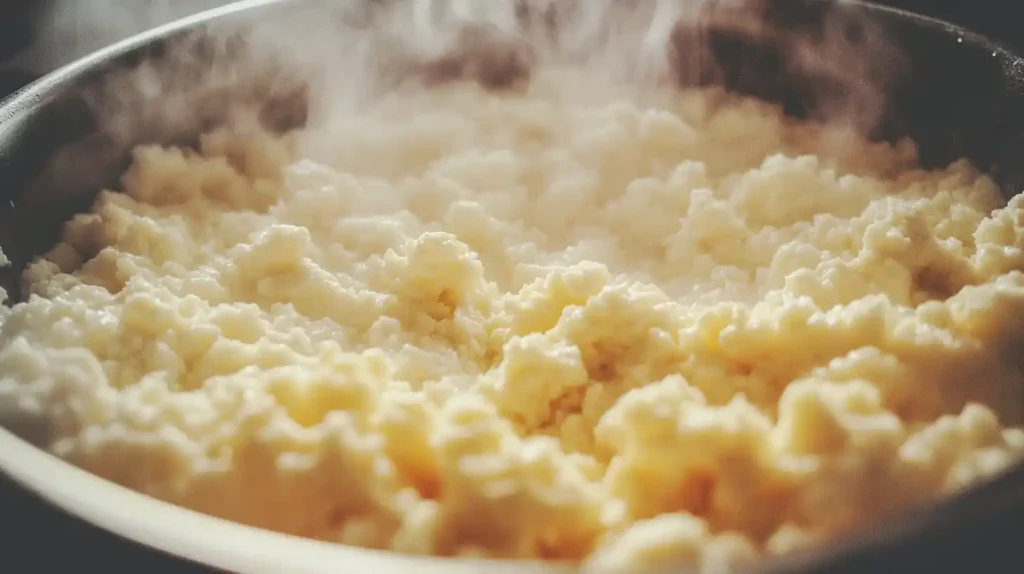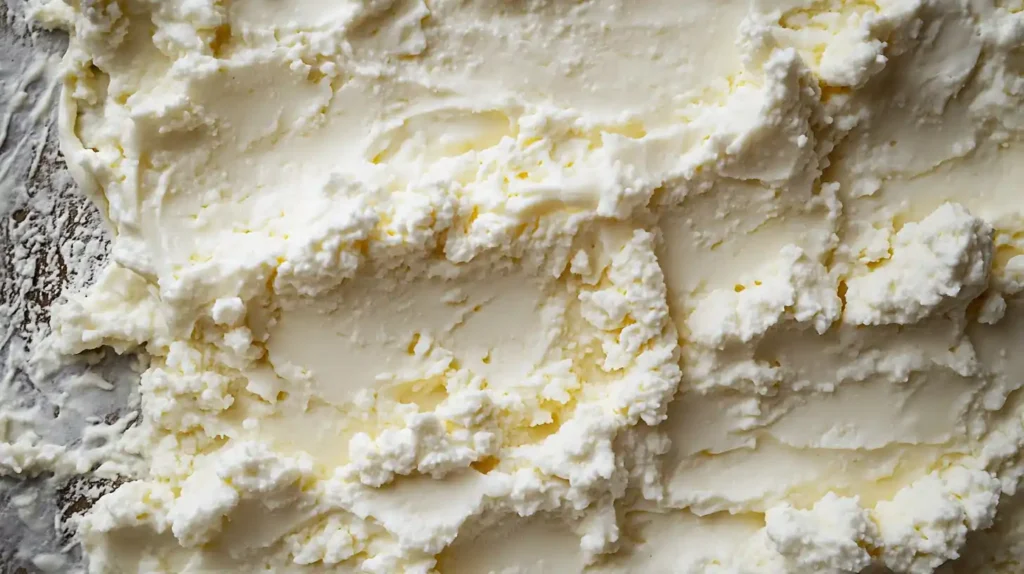Does cottage cheese melt in the oven? This common question has a surprising answer. Unlike cheeses such as mozzarella or cheddar, cottage cheese behaves differently when heated. Instead of melting, it separates, creating a unique texture that works well in many recipes.
Understanding why cottage cheese doesn’t melt in the oven can help you use it effectively in your cooking. Whether you’re baking a lasagna or making a casserole, knowing how this cheese works is essential.
- Moisture and curds: Cottage cheese is made from small curds mixed with whey, which contains a lot of water. The high moisture content prevents it from melting like other cheeses.
- Low fat: Many melting cheeses are high in fat, which helps them become creamy under heat. Cottage cheese has less fat, so it doesn’t behave the same way.
- Delicate curds: The curds in cottage cheese are soft and fragile. When heated, they lose their shape and texture instead of melting.
Even though it doesn’t melt, cottage cheese still works wonderfully in many recipes. Its creamy texture and mild flavor make it a great addition to baked dishes.
Table of contents
Why Doesn’t Cottage Cheese Melt?
If you’ve ever wondered why cottage cheese doesn’t behave like other cheeses, the answer lies in its structure. Unlike high-fat, low-moisture cheeses, cottage cheese has a high water content and low fat, which prevent it from melting smoothly. When heated in the oven, the curds separate, creating a creamy but distinct texture.
To discover new ways to bake with this distinctive cheese, consider: Does cottage cheese melt in the oven, or can it still form creamy layers? Learn how to add it to your favorite recipes!

For baking inspiration using this non-melting cheese, check out The Ultimate Guide to Making the Perfect Cottage Cheese Bake. This resource explains how cottage cheese can create creamy layers in dishes without melting.
1. High Moisture Content
One of the key reasons cottage cheese doesn’t melt is its high water content. Unlike aged cheeses that are firmer and contain less moisture, cottage cheese is soft and wet because it’s made of curds suspended in whey. When exposed to heat, the water evaporates instead of blending into a melted consistency. This leaves the curds intact but slightly dry or watery.
2. Low Fat Levels
The fat in cheese plays a crucial role in the melting process. Higher-fat cheeses, like cheddar or gouda, melt smoothly because the fat helps create a stretchy and gooey texture. Cottage cheese is much lower in fat, which means it doesn’t have the same properties that allow other cheeses to melt into a liquid form.
3. Protein Structure of the Curds
Cottage cheese curds are made primarily of casein, a type of protein that solidifies under heat. These proteins form a delicate network in the curds, which holds its shape. When heated, this network doesn’t break down like it would in other cheeses. Instead, the curds contract and separate from the moisture, making cottage cheese more watery rather than melted.
4. Lack of Emulsifiers
Many melting cheeses contain emulsifiers, which help fat and water mix evenly during heating. Cottage cheese lacks these, so its water and fat separate under heat instead of blending into a smooth consistency. This is another reason why it doesn’t melt in the same way.
How Does This Affect Cooking?
Because cottage cheese doesn’t melt, it won’t create the stretchy or gooey textures you might expect from other cheeses. However, this characteristic doesn’t limit its use. Instead, cottage cheese brings a creamy and slightly tangy flavor to recipes. It’s a fantastic option for dishes where a smooth, rich texture is needed without the melting effect.
For example:
- Use it in lasagna or casseroles as a creamy layer.
- Blend it into soups or sauces for added protein and creaminess.
- Mix it with other ingredients to create spreads or dips.
Cottage cheese may not behave like other cheeses in the oven, but that’s part of its charm. Its non-melting nature opens up new possibilities for cooking, making it a versatile ingredient that can add texture and flavor to your dishes in unique ways.
How to Use Cottage Cheese in Baking
Even though cottage cheese doesn’t melt in the oven, it’s a fantastic addition to many baked dishes. For instance:
- Layer it in casseroles or lasagna: Cottage cheese works well as a creamy base, even if it doesn’t melt like other cheeses.
- Bake it into brownies or muffins: For a nutritious twist, try using cottage cheese in desserts like these Cottage Cheese Brownies.
- Stuff pasta shells: Its rich texture makes it perfect for fillings that don’t rely on melting.
Its versatility makes it ideal for both sweet and savory recipes.
1. Layer It in Casseroles or Lasagna
One of the most popular ways to use cottage cheese in baking is as a creamy layer in casseroles or lasagna. Instead of ricotta cheese, which is more expensive or harder to find, cottage cheese can provide a similar texture and flavor.
- How to prepare it: Blend cottage cheese with a little milk or cream for a smoother consistency. Add herbs like parsley, basil, or oregano for extra flavor.
- Layer it up: Use the mixture as one of the layers in your lasagna, alternating it with pasta sheets, tomato sauce, and vegetables or meat.
This not only adds creaminess but also boosts the protein content of the dish, making it more nutritious.
2. Use It in Baked Goods for Moisture
Cottage cheese works wonders in baked goods like muffins, breads, and pancakes. It keeps the batter moist and adds a subtle tangy flavor without overpowering the dish.
- Muffins and quick breads: Add a scoop of cottage cheese to your batter for a softer, moister texture. This is especially useful for whole-grain recipes that tend to be drier.
- Pancakes: Incorporate cottage cheese into your pancake batter. It will make them fluffy and rich while adding a protein boost.

3. Blend It for Cheesecake or Dessert Fillings
Blended cottage cheese is an excellent alternative to cream cheese or ricotta in cheesecakes and other desserts. Its smooth texture and tangy flavor make it a perfect match for sweet recipes.
- Cheesecake base: Blend cottage cheese until smooth and combine it with eggs, sugar, and vanilla. Pour it over a graham cracker crust and bake as you would a regular cheesecake.
- Dessert fillings: Use blended cottage cheese as a filling for crepes, fruit tarts, or stuffed pastries.
This substitution is lower in fat and calories than traditional options, making it a healthier choice for dessert lovers.
4. Add It to Savory Bakes
Cottage cheese can also shine in savory baked goods like stuffed vegetables, quiches, or savory pies.
- Stuffed vegetables: Mix cottage cheese with cooked spinach, garlic, and spices, then use it to stuff peppers, zucchinis, or tomatoes before baking.
- Quiches and savory pies: Combine cottage cheese with eggs, grated cheese, and your favorite vegetables or proteins for a creamy, savory filling.
5. Bake It Into the Dish Itself
Instead of just using cottage cheese as a filling or layer, you can incorporate it directly into the dish.
- Breads and rolls: Add cottage cheese to bread dough for extra softness and a unique flavor.
- Egg bakes: Mix cottage cheese with eggs, vegetables, and seasonings to create a fluffy breakfast bake.
Tips for Baking with Cottage Cheese
- Blend for Smoothness: If you prefer a smoother texture, blend cottage cheese before adding it to recipes.
- Pair with Bold Flavors: Combine it with strong herbs, spices, or sweeteners to enhance its taste.
- Keep It Moist: Since cottage cheese is already moist, be cautious about adding too much extra liquid to your recipes.
Cottage cheese is an unexpected hero in baking. Whether you’re making a sweet dessert, a savory casserole, or a hearty loaf of bread, it can add moisture, creaminess, and a nutritional boost to your recipes. Give it a try and see how this humble ingredient can elevate your baked goods!
What Makes Cottage Cheese So Healthy?
Cottage cheese isn’t just tasty—it’s also packed with nutrients that can improve your diet. Let’s explore why it’s a healthy choice for many people.
- High in protein: Just one cup of cottage cheese contains around 28 grams of protein. This makes it a fantastic option for muscle repair and growth. Protein also helps you feel full longer, which is great for managing hunger.
- Low in calories: Compared to most cheeses, cottage cheese is lower in calories. This makes it ideal for anyone trying to lose weight or maintain a healthy diet.
- Rich in essential nutrients: Cottage cheese is loaded with calcium and phosphorus, which are key for strong bones. It also contains B vitamins that support energy production and brain health.
- Lower lactose content: If you’re sensitive to lactose, cottage cheese is often easier to digest than other dairy products. However, it’s not completely lactose-free, so tolerance varies.
For those who want to explore the full health benefits, check out How Many Calories Are in Olive Garden Chicken Parmigiana Lunch?
FAQs About Cottage Cheese and Heat
Many people have questions about cottage cheese and how it reacts to heat. Let’s answer some of the most common ones.
Does Cottage Cheese Melt?
No, cottage cheese doesn’t melt like cheddar or mozzarella. Instead, its high moisture content causes it to separate and become watery when heated.
Can You Make Cottage Cheese Creamy?
Yes, blending cottage cheese with milk, cream, or even yogurt can create a smooth and creamy texture. This works well for sauces, soups, or as a base for dips.
What Recipes Work Best with Cottage Cheese?
Cottage cheese is perfect for recipes that don’t rely on melting. Try it in:
- Lasagna: Use it as a creamy layer instead of ricotta.
- Pancakes: Add it to pancake batter for extra fluffiness.
- Cheesecake: Blend it for a lighter, protein-packed filling.
- Stuffed vegetables: Combine it with herbs and spices for a tasty filling.
Can You Bake Cottage Cheese?
Yes! Cottage cheese bakes beautifully, especially in dishes like casseroles or bread. It holds its flavor and adds a rich, creamy texture.
Is Cottage Cheese Lactose-Free?
While cottage cheese is lower in lactose than milk or soft cheeses, it isn’t completely lactose-free. People with lactose intolerance should consume it cautiously.
With its versatility, cottage cheese is a great addition to your kitchen. It’s especially useful in recipes where you want creaminess without needing the cheese to melt.
Tips for Cooking with Cottage Cheese
Cooking with cottage cheese can be simple and rewarding if you know how to use it well. Here are some tips to help you make the most of this unique ingredient:
1. Enhance Its Flavor
If you’re not a fan of the plain taste of cottage cheese, try adding:
- Sweet toppings: Honey, fresh fruit, or cinnamon.
- Savory spices: Dill, garlic, or paprika.
- Texture boosters: Chopped nuts, seeds, or granola.
These additions can transform cottage cheese into a flavorful snack or side dish.
2. Blend for a Smooth Texture
Blending cottage cheese can make it creamy and smooth. Use it as:
- A base for dips or spreads.
- A substitute for cream in soups or sauces.
- A filling for desserts like cheesecake.
3. Store It Properly
Always refrigerate cottage cheese after opening. To keep it fresh:
- Use an airtight container.
- Consume it within a week.
- Avoid freezing unless you’ll use it in cooked dishes like casseroles, as freezing changes its texture.
4. Pair It with the Right Dishes
Cottage cheese works best in recipes that don’t rely on melting. Use it in:
- Pasta dishes.
- Baked goods like muffins or bread.
- Smoothies for added creaminess and protein.
5. Experiment Freely
Don’t be afraid to try cottage cheese in new ways. It’s a versatile ingredient that can fit into almost any meal, from breakfast to dinner.
Is Cottage Cheese Good for Weight Loss?
If you’re looking for a food that supports weight loss, cottage cheese is an excellent choice. Its unique combination of nutrients and low calorie count makes it a favorite for many health-conscious individuals.
1. High Protein Keeps You Full
Protein is key for staying satisfied after meals, and cottage cheese is packed with it. Just one cup provides about 28 grams of protein. This helps curb hunger and reduces the temptation to snack on unhealthy foods.
2. Low in Calories
Cottage cheese is low in calories compared to other cheeses. For instance, one serving typically contains less than 200 calories. This allows you to enjoy its creamy texture and rich taste without worrying about your calorie intake.
3. A Low-Carb Option
For those following a low-carb or ketogenic diet, cottage cheese is a great option. It contains very few carbohydrates, making it ideal for those monitoring their carb intake.
4. Supports Muscle Growth
The protein in cottage cheese isn’t just good for curbing hunger—it’s also great for muscle repair and growth. This is especially important if you’re combining your weight loss plan with regular exercise.
5. Easy to Incorporate into Meals
Cottage cheese is versatile and can be added to:
- Smoothies for a creamy texture.
- Salads for an extra protein boost.
- Snacks paired with fresh fruits or vegetables.
By including cottage cheese in your diet, you can create meals that are both satisfying and supportive of your weight loss goals.
Final Thoughts
Does cottage cheese melt in the oven? This is a question that many cooks and baking enthusiasts ask. Unlike traditional melting cheeses like mozzarella or cheddar, cottage cheese doesn’t behave the same way when exposed to heat. Understanding why cottage cheese doesn’t melt in the oven can help you use it more effectively in your recipes.
What sets cottage cheese apart isn’t just how it behaves when heated, but also the health benefits it provides. It’s high in protein, low in calories, and full of essential nutrients, making it an excellent choice for weight loss and a balanced diet.
If you’re new to cooking with cottage cheese, don’t hesitate to experiment. Try it as a creamy base for sauces, a filling for stuffed pasta, or even as an addition to your favorite baked goods. The key is to embrace its uniqueness and let it enhance your meals in ways that melted cheeses can’t.

With these tips and ideas, you can transform cottage cheese into a star ingredient in your kitchen. Give it a try today, and see how this humble food can add something special to your cooking!

